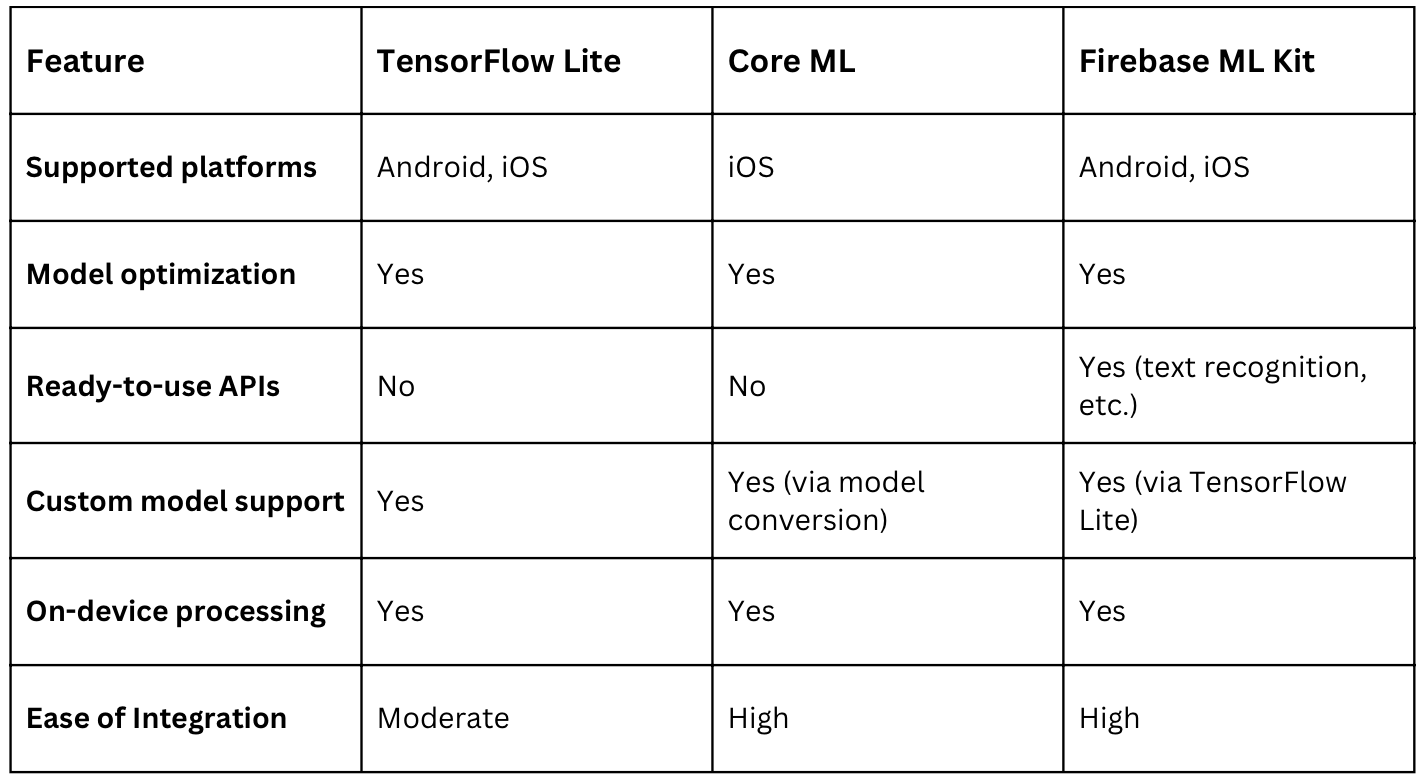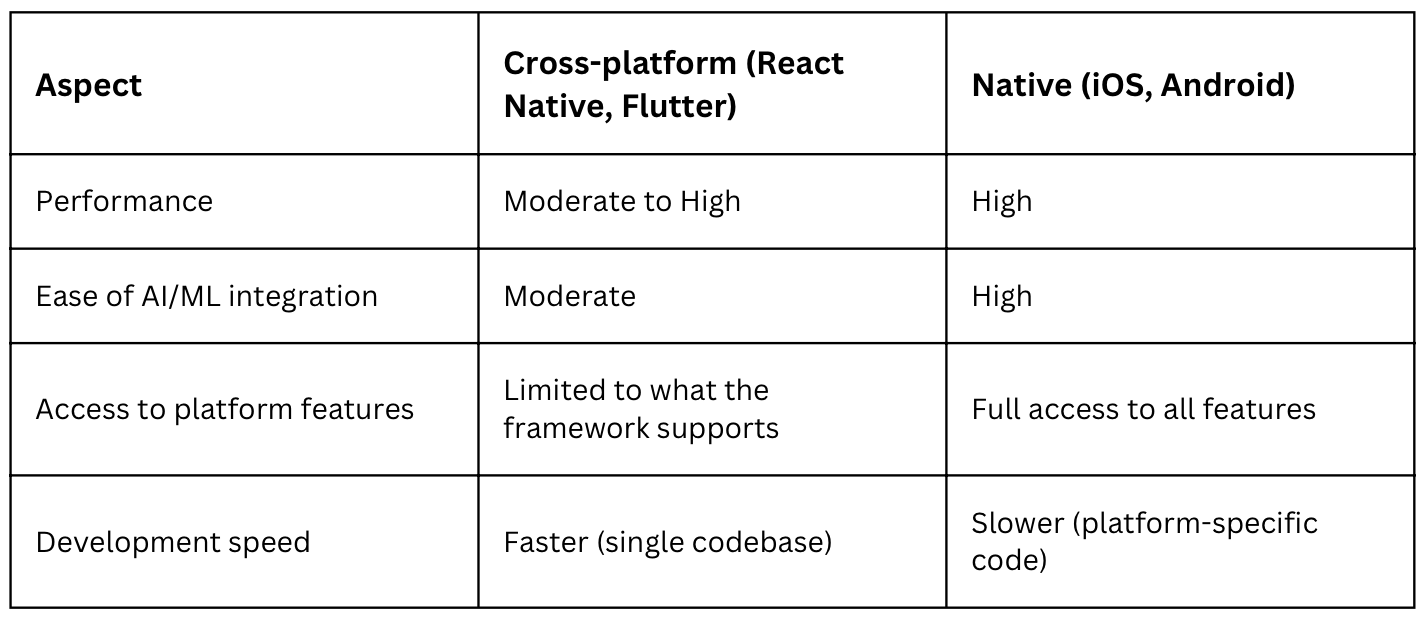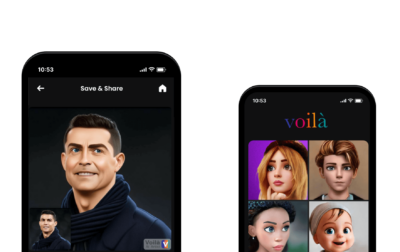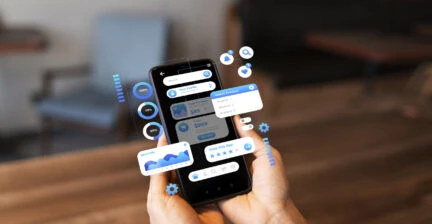AI and machine learning in mobile development
Artificial intelligence (AI) and machine learning (ML), its subset, are the tech innovations redefining mobile app development. They are turning smartphones into assistants that create customized experiences based on their predictions of our needs.
We invite you to join Touchlane’s mobile team and see the advantages of artificial intelligence and machine learning for mobile development.
Understanding AI and ML
If you are new to both AI and ML, here are some basic things you need to know before learning about the technologies that can power up your mobile app.
In essence, artificial intelligence, or AI, is trying to simulate human behavior. AI systems are capable of tasks that would usually need human intelligence – comprehending speech, identifying patterns, and making judgments.
Machine learning is a subset, or special kind, of AI that teaches computers to gain knowledge through experience without being told exactly what to do. These smart systems can make predictions, spot patterns in data, and get better at their job the more data they see.
In short, AI and ML are the instruments to personalize and enhance your smartphone experience.
These two can be used in several ways. For example:
- Personalized experiences. AI-powered apps recognize your interests and recommend something like products or TV shows based on them. Example: Netflix.
- Smarter interactions. Voice assistants make it easier to talk to your phone and get help or information quickly. Think Siri or Alexa.
- Predicting the future. Apps can anticipate what you need and offer helpful suggestions based on your habits. (Ride-hailing app suggestions)
- Seeing and understanding. Smartphones can recognize faces, objects, and speech, which leads to features like augmented reality. Example: Pokemon GO.
- Content creation. Generative AI models are capable of producing new content in various formats, including text, images, audio, video, and code, based on provided inputs.
As these technologies develop, there will be a greater and deeper integration of them into mobile apps.

Tools and frameworks for integrating AI/ML in mobile apps
Theory aside, how do you integrate AI or ML into apps? Building smart mobile apps requires powerful frameworks. They help handle complex on-device calculations and process huge amounts of data without slowing down your device.
Let’s explore some of the most popular options.
TensorFlow Lite
TensorFlow Lite is a specialized version of TensorFlow designed to run ML models efficiently on smartphones and other limited-resource devices.
It excels at:
- Optimizing models, making them smaller and faster for mobile use.
- Cross-platform compatibility as it works on both Android and iOS devices.
Core ML
This is Apple’s framework for bringing AI into iOS apps. Core ML is designed to work smoothly with Apple devices and allows development teams to integrate various ML models into apps.
Key features include:
- In-app learning. Due to CoreML’s support for incremental training, models can learn from new data without going through a full retraining procedure. This is especially helpful for apps that have to adjust to shifting user preferences or environmental conditions.
- Hardware acceleration. To provide high-performance ML computations, CoreML makes use of the Neural Engine and additional specialized hardware on Apple devices.
Firebase ML Kit
Google’s robust framework, Firebase ML Kit, enables programmers to include smart features in mobile apps. With its ease of integration for such tasks as object identification, text reading, and facial recognition, it is an excellent tool for both experienced and new developers.
Firebase ML Kit’s essential feature is its cross-platform compatibility: this framework is a good choice for cross-platform app development because it works with both iOS and Android.

ML and AI in mobile app development: cross-platform vs. native
When designing mobile apps with AI or ML, developers often face a tough decision: should they use a versatile framework that works on both Apple and Android devices (React Native, Flutter), or should they create separate, custom versions for each platform?
Cross-platform development
React Native is a framework that lets developers build mobile solutions with JavaScript, the same language used for websites. It is designed to work on both Apple and Android devices. But while React Native can connect to the core features of your phone, handling complex AI or machine learning tasks might need extra specialized code.
Flutter is another tool for building apps that work on both Apple and Android devices. It is made by Google and uses a programming language called Dart. Flutter apps tend to feel and run more like native apps. While you can add AI or ML to Flutter apps, you might need to do some extra work, especially if you are using tools like TensorFlow Lite or Firebase ML Kit, to make sure everything works smoothly on both types of phones.
Native development
iOS (Swift/Objective-C)
Using Swift or Objective-C to develop an app for Apple iPhones and iPads provides developers with the best tools for working with Apple’s AI technology, Core ML. These apps can fully utilize the latest capabilities on the iPhone – and they are faster.
Android (Java/Kotlin)
Using TensorFlow Lite and Firebase ML Kit, two of Google’s AI tools, is a simple task when you write an Android app using Java or Kotlin. Such applications function flawlessly and take full advantage of all of Google’s AI capabilities.

Build your AI-powered app with Touchlane
Challenges and moral issues
While both ML and AI are an undeniable presence in many popular apps, there are things to keep in mind while using them.
Bias in AI and ML models
The potential for impartiality in AI is one of its main issues. This may occur as a result of bias in the data that the AI was trained on or from shortcomings in the AI itself. Ensuring that AI treats everyone equitably is crucial, thus engineers must thoroughly inspect and enhance their AI systems.
User security challenges when handling AI/ML
People may be concerned about their privacy because AI frequently requires a large amount of data to function effectively. This data must remain confidential and secure. Processing the data directly on the user’s phone rather than transferring it to a data center is one method to accomplish this.
AI/ML vs user autonomy
While AI is excellent at making recommendations, it can also restrict what users see. AI may fail to present them with novel and intriguing content if it just displays items that are comparable to what they currently enjoy. Thus, striking a balance between providing your app’s users with tailored advice and allowing them to consider your options is crucial.
Conclusion
The way we use apps is entirely changing due to AI. They are becoming more intelligent and relatable, which retains attention and promotes corporate expansion. Whether you are building apps for Apple or Android – or both – some fantastic tools like TensorFlow Lite, Core ML, and Firebase ML Kit make it easy to incorporate AI into apps.
However, since AI is not flawless, we must exercise caution when it comes to issues like privacy. The use of AI should be prudent as it continues to advance for the good of all. At Touchlane, we successfully work with both technologies and will be happy to explain how to use AI in mobile apps. Explore our custom full-stack development services or contact our technology experts here.
RELATED SERVICES
CUSTOM SOFTWARE DEVELOPMENT
If you have an idea for a product along with put-together business requirements, and you want your time-to-market to be as short as possible without cutting any corners on quality, Touchlane can become your all-in-one technology partner, putting together a cross-functional team and carrying a project all the way to its successful launch into the digital reality.
If you have an idea for a product along with put-together business requirements, and you want your time-to-market to be as short as possible without cutting any corners on quality, Touchlane can become your all-in-one technology partner, putting together a cross-functional team and carrying a project all the way to its successful launch into the digital reality.
We Cover
- Design
- Development
- Testing
- Maintenance











